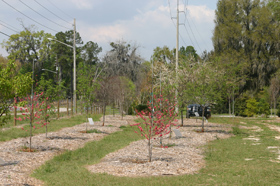Testing protocol 
In a search for trees that are compatible with overhead power lines, we wanted to test the growth patterns, suitability for nursery production, and maintenance requirements of about 70 small maturing trees. Three trees were planted of each species or cultivar in late summer 2006 in Gainesville (see photo) and one plant of many of the trees were planted on University of Florida Agricultural research facility in Citra, 20 miles south of Gainesville. Most trees were positioned in full sun about 15 to 20 feet apart in mulched strips about 10 feet wide (see photo); trees positioned in morning shade are so indicated in the detailed information on each tree.
Most trees were planted from containers because many of the uncommon trees were only available in small sizes in containers. The more common trees were planted from field nursery stock if available. All photos were taken at the test site; however, we link from our tree pages to photos taken at other places.
The top of the root ball was positioned even with the landscape soil. In order to evaluate what is typically done in most landscapes today, no attempt was made to treat or cut circling roots on any trees. Some trees had circling roots visible at the surface of the root ball. Irrigation was provided for the first year then only periodically in drought. Fertilizer was applied three times each year at one pound nitrogen per thousand square feet per application. Mulch was chipped line clearance debris; no mulch was placed over the root ball.

